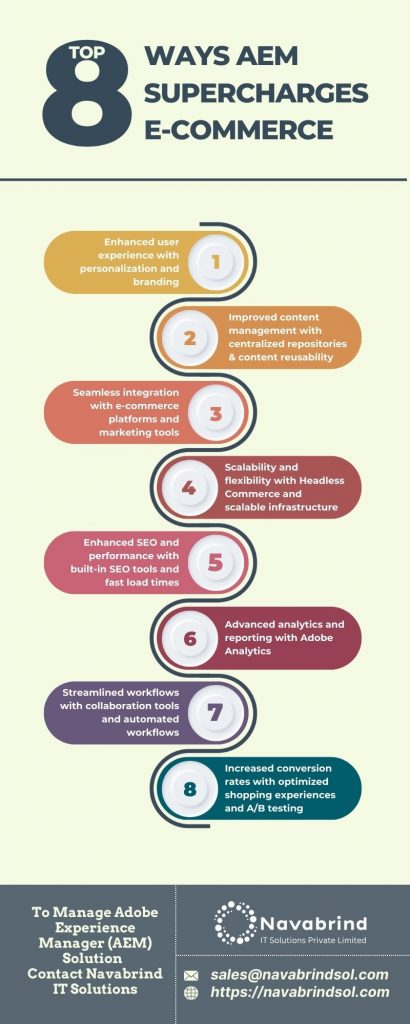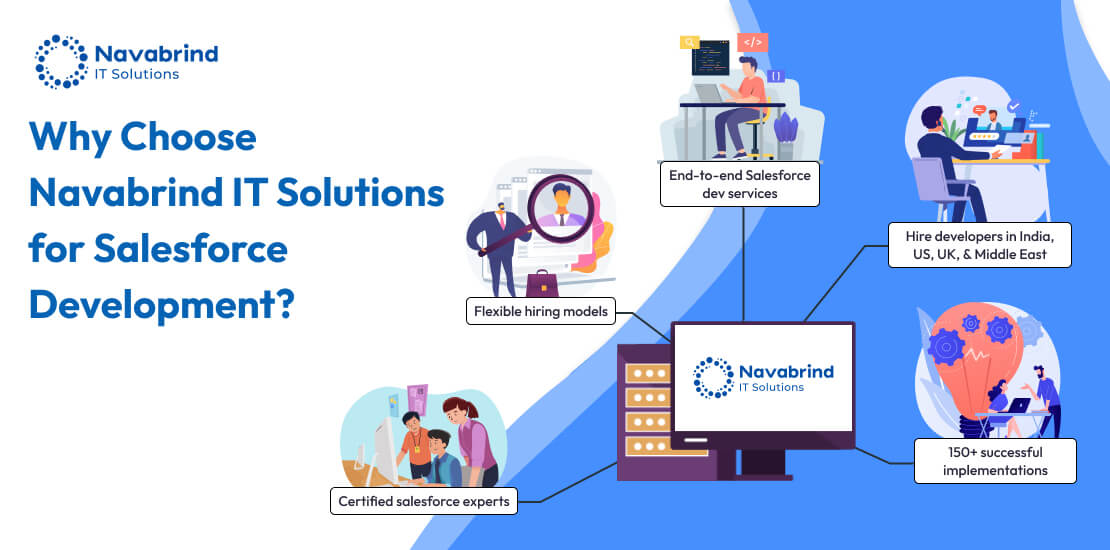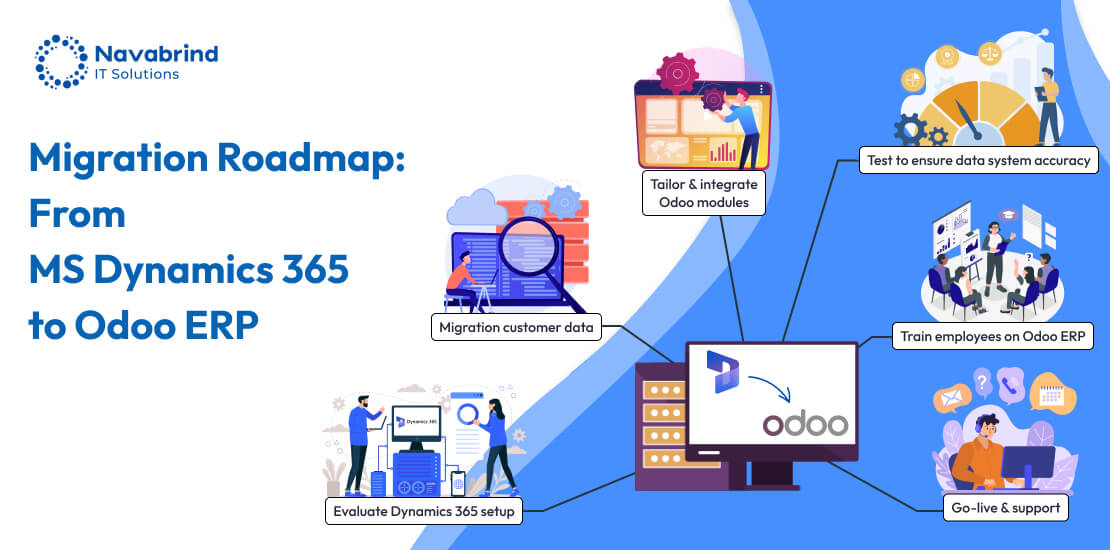Top 8 Benefits of Adobe Experience Manager for the E-Commerce Industry
- November 13, 2024
- Posted by:
- Category: Uncategorized
Adobe Experience Manager (AEM) stands out as a premier content management solution, offering a host of benefits that elevate digital experiences. It provides seamless content management with an intuitive interface, enables personalized customer engagement through data-driven insights, and ensures consistent multi-channel delivery. AEM’s robust digital asset management, scalability, and integration with other Adobe products enhance operational efficiency and collaboration. Advanced analytics, strong security features, and ongoing innovation and support further cement AEM as an indispensable tool for businesses aiming to streamline operations, optimize content, and deliver exceptional customer experiences in the ever-evolving digital landscape.
The ability to manage content effectively is crucial for businesses aiming to enhance their online presence and customer experience. Adobe Experience Manager (AEM), is a comprehensive content management solution that enables businesses to create, manage, and deliver personalized digital experiences across various channels.
One of the primary advantages of AEM is its seamless content management capabilities. AEM provides a user-friendly interface that allows marketers and content creators to manage and update content without the need for extensive technical knowledge. This drag-and-drop interface simplifies the creation, editing, and publication of content, enabling teams to work more efficiently and focus on crafting compelling narratives rather than wrestling with the technicalities of content management.
AEM excels in delivering personalized customer experiences. By leveraging data from various sources, including customer profiles, behavior, and preferences, AEM enables businesses to tailor content to individual users. This level of personalization helps in engaging customers more effectively, leading to higher conversion rates and improved customer satisfaction. The ability to deliver the right content to the right audience at the right time is a significant competitive advantage in today’s market.
In a world where customers interact with brands across multiple touchpoints, from websites and mobile apps to social media and email, AEM’s multi-channel delivery capabilities are invaluable. AEM allows businesses to create content once and publish it across channels, ensuring a consistent brand message and user experience. This not only saves time and resources but also ensures that customers receive a cohesive experience regardless of the platform they use.
Managing digital assets efficiently is a challenge for many organizations. AEM’s Digital Asset Management (DAM) system offers a centralized repository for all digital assets, including images, videos, documents, and more. This makes it easy to organize, search, and retrieve assets, streamlining workflows and ensuring that teams have quick access to the resources they need. The DAM also supports version control, ensuring that the latest versions of assets are always available.
Adobe Experience Manager is designed to grow with your business. Whether you’re a small business just starting out or a large enterprise with complex needs, AEM’s scalable architecture can accommodate your requirements. Its modular design allows businesses to add or remove features as needed, ensuring that they only pay for what they use. This flexibility makes AEM a cost-effective solution that can adapt to changing business needs over time.
Collaboration and efficient workflow management are critical for successful content creation and publication. AEM offers robust tools for collaboration, allowing multiple team members to work on projects simultaneously. Its workflow management features enable the automation of content approval processes, ensuring that content is reviewed and approved by the appropriate stakeholders before publication. This reduces bottlenecks and accelerates time-to-market.
One of the standout benefits of AEM is its seamless integration with other Adobe products, such as Adobe Analytics, Adobe Target, and Adobe Campaign. This integration enables businesses to leverage the full power of the Adobe Marketing Cloud, gaining deeper insights into customer behavior, optimizing content for better performance, and orchestrating personalized marketing campaigns. The unified ecosystem ensures that data flows smoothly between different tools, providing a comprehensive view of customer interactions.
Understanding how content performs is crucial for optimizing digital strategies. AEM’s advanced analytics and reporting capabilities provide detailed insights into content performance, user engagement, and conversion rates. These insights enable businesses to make data-driven decisions, refine their content strategies, and continuously improve the customer experience. By identifying what works and what doesn’t, businesses can allocate resources more effectively and achieve better results.
Security and compliance are paramount in today’s digital landscape. AEM offers robust security features, including role-based access control, encryption, and secure data storage, to protect sensitive information and ensure compliance with industry regulations. Its built-in compliance tools help businesses adhere to data privacy laws, such as GDPR, ensuring that customer data is handled responsibly and ethically. This level of security and compliance is essential for building trust with customers and safeguarding the business’s reputation.
How E-commerce Businesses Can Benefit for AEM
E-commerce businesses can reap numerous benefits from integrating Adobe Experience Manager (AEM). Here are some key advantages:

- Enhanced User Experience:
- Personalization: AEM allows businesses to deliver personalized content and product recommendations based on customer behavior and preferences, leading to higher engagement and conversion rates.
- Consistent Branding: Ensures a cohesive and consistent brand experience across all channels, including web, mobile, social media, and in-store digital displays.
- Improved Content Management:
- Centralized Content Repository: AEM provides a centralized platform to manage all digital assets, making it easier to create, manage, and distribute content.
- Content Reusability: Content fragments and templates can be reused across different pages and channels, streamlining the content creation process.
- Seamless Integration:
- E-commerce Platforms: AEM integrates smoothly with popular e-commerce platforms like Magento, SAP Commerce Cloud, and custom solutions, ensuring real-time synchronization of product data and inventory.
- Marketing Tools: Integration with Adobe Marketing Cloud, including Adobe Target, Adobe Analytics, and Adobe Campaign, allows for advanced marketing automation and analytics.
- Scalability and Flexibility:
- Headless Commerce: AEM supports headless commerce architectures, providing flexibility to deliver content across various touchpoints and devices without being tied to a specific front-end framework.
- Scalable Infrastructure: AEM’s cloud-based infrastructure ensures scalability to handle increasing traffic and content demands.
- Enhanced SEO and Performance:
- SEO Optimization: Built-in SEO tools and best practices help improve search engine rankings, making it easier for customers to find products online.
- Fast Load Times: Optimized delivery of images and videos ensures faster load times, improving user experience and reducing bounce rates.
- Advanced Analytics and Reporting:
- Detailed Insights: Integration with Adobe Analytics provides comprehensive insights into user behavior, site performance, and conversion metrics.
- Data-Driven Decisions: Businesses can make informed decisions based on data, leading to better targeting and improved marketing strategies.
- Streamlined Workflows:
- Collaboration Tools: AEM’s collaboration tools enable teams to work together efficiently on content creation and approval processes.
- Automated Workflows: Automated workflows streamline content publishing, reducing manual effort and speeding up time-to-market.
- Increased Conversion Rates:
- Optimized Shopping Experiences: Personalized and content-rich shopping experiences lead to higher customer satisfaction and increased conversion rates.
- A/B Testing: Continuous optimization through A/B testing helps identify the best-performing content and strategies.
By leveraging Adobe Experience Manager, e-commerce businesses can create engaging, personalized, and efficient shopping experiences that drive growth and customer loyalty.
Conclusion
Adobe Experience Manager is a powerful tool that offers a myriad of benefits for businesses looking to enhance their digital presence and deliver exceptional customer experiences. From seamless content management and personalized customer experiences to robust digital asset management and strong security, AEM provides the tools and capabilities needed to succeed in the digital age. By leveraging AEM, businesses can streamline their operations, improve collaboration, and achieve better results, ultimately driving growth and success in today’s competitive market. Whether you’re a small business or a large enterprise, AEM’s scalability, flexibility, and continuous innovation make it a valuable investment for any organization looking to thrive in the digital era.
Navabrind IT Solutions has extensive experience maintaining, integrating and upgrading Adobe products. If your e-commerce business needs support with Adobe Experience Manager, email sales@navabrindsol.com to start a conversation.
As a process driven digital e-commerce solutions provider, we have a track record of delivering world-class solutions for over a decade.
Schedule a conversation with us now!
Related Articles
A Business Case for Hiring Dedicated Salesforce Developers
A Business Case for Hiring Dedicated Salesforce Developers March 21, 2025 Posted by: Tony Stark Categories: Blog, Hire a Developer, Odoo No Comments The Growing Need for Salesforce Development Services Salesforce has established itself as the world’s leading CRM, empowering businesses of all sizes to streamline customer interactions and improve sales processes. However, to experienceMarch 21, 2025 Read moreERP Migration from MS Dynamics 365 Business Central to Odoo
ERP Migration from MS Dynamics 365 Business Central to Odoo March 19, 2025 Posted by: adminuser Categories: Blog, ERP Migration, Odoo No Comments Migrating from Microsoft Dynamics 365 Business Central to Odoo ERP Solutions is a strategic move for businesses seeking flexibility, cost efficiency, and seamless integration. While MS Dynamics is a powerful ERP, manyMarch 19, 2025 Read moreAdopt a Robust Quality Management System with PPAP in Odoo ERP
November 13, 2024 Read more
How can we help you?
Get in touch with a solutions consultant that can share best practices and help solve specific challenges.





